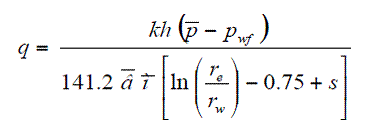Re: Timeline
in response to
by
posted on
May 12, 2009 06:12PM

Developing large acreage positions of unconventional and conventional oil and gas resources

I thought Darcy's Law looked simple enough, until I came across this :)
Definition of an Unconventional Gas Reservoir
In the 1970s, the United States government defined a tight gas reservoir as one in which the expected value of permeability to gas flow would be less than 0.1 md. This definition was a political definition that has been used to determine which wellswould receive federal or state tax credits for producing gas from tight reservoirs.
Actually, the definition of a tight gas reservoir is a function of many physical and economic factors. The following equation, known as Darcy’s Law, relates these physical factors.’

The above equation clearly shows that the flow rate, q, is a function of permeability k; net pay thickness h; reservoir pressure p ; flowing pressure pwf; formation volume factor and gas viscosity evaluated at the average pressure, !μ ; drainage area re; wellbore radius rw; and skin factor s. Thus, to choose a single value of permeability to define “tight gas or unconventional gas” is of limited significance. In deep, high-pressure, thick reservoirs, commercial completions can be achieved when the formation permeability to gas is in the microdarcy range (0.001 md). In shallow, low-pressure, thin reservoirs, permeabilities of several millidarcies might be required to produce the gas at economic flow rates, even after a successful fracture treatment.
One way to define unconventional gas is as “natural gas that cannot be produced at economic flow rates nor in economic volumes of natural gas unless the well is stimulated by a large hydraulic fracture treatment, a horizontal wellbore, or by using multilateral wellbores or some other technique to expose more of the reservoir to the wellbore.”
So what is a typical unconventional gas reservoir? The answer is that there are no “typical” unconventional gas reservoirs. An unconventional gas reservoir can be deep or shallow; high pressure or low pressure; high temperature or low temperature; blanket or lenticular; homogeneous or naturally fractured; and containing a single layer or multiple layers. The optimum drilling, completion, and stimulation methods for each well are a function of the reservoir characteristics and the economic situation. Unconventional gas reservoirs in south Texas may have reservoir properties that are significantly different from those in South America or the Middle East. The costs to drill, complete, and stimulate these wells, as well as the gas price and the gas market affect how tight-gas reservoirs are developed.